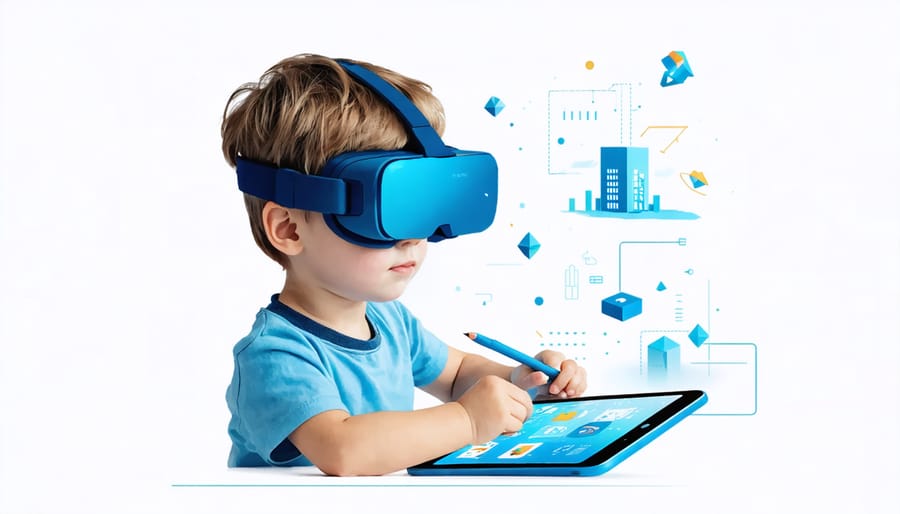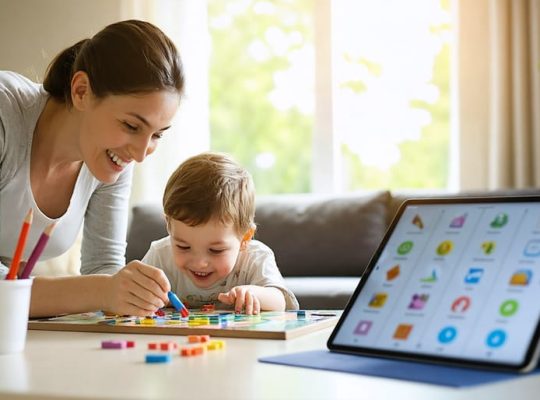As parents navigating the digital age, we’re witnessing a profound transformation in how our children interact with technology. The convergence of 5G networks and artificial intelligence isn’t just another tech upgrade – it’s reshaping our children’s educational experiences, social connections, and daily routines in ways we’re only beginning to understand.
This lightning-fast 5G connectivity, combined with AI’s intelligent capabilities, brings both exciting opportunities and important considerations for our children’s digital well-being. From AI-powered educational apps that adapt to your child’s learning style to immersive virtual classrooms made possible by 5G’s minimal latency, these technologies are creating new possibilities for personalized learning and development.
However, as caregivers, we need to thoughtfully consider how this technological revolution affects our children’s mental health, screen time habits, and social development. While these advances promise enhanced learning experiences and creative opportunities, they also raise important questions about digital boundaries, privacy, and healthy technology use.
In this guide, we’ll explore practical strategies to help your family embrace the benefits of 5G and AI while maintaining a balanced, mindful approach to technology use. Together, we’ll discover how to nurture our children’s digital literacy while protecting their emotional and psychological well-being in this rapidly evolving technological landscape.
Understanding the New Digital Landscape
The Speed Revolution: What 5G Means for Kids
The arrival of 5G has transformed how children interact with their digital world, making everything faster and more immediate than ever before. Where kids once waited patiently for videos to buffer or games to load, they now have instant access to high-quality content and seamless online experiences.
This enhanced speed means children can participate in more sophisticated virtual learning environments, join high-quality video calls with friends and family, and enjoy immersive educational content without technical frustrations. For example, a student can now take a virtual tour of ancient Rome or participate in a live science experiment with classmates across the city without lag or interruption.
However, this incredible speed also brings new challenges. The instant gratification of 5G can affect children’s patience and attention spans. Many parents report that their kids become easily frustrated when faced with even minor delays in other aspects of life.
To help children maintain a healthy relationship with this technology, it’s important to establish regular offline activities and create opportunities for practicing patience. Simple activities like board games, reading physical books, or engaging in hands-on crafts can help balance the immediate nature of the digital world with the natural pace of real-life experiences.
AI’s Growing Role in Children’s Apps and Games
Artificial Intelligence is increasingly shaping the digital experiences of our children, particularly in educational apps and games. Modern children’s applications now incorporate AI to adapt to each child’s learning pace, providing personalized content that grows with them. For instance, reading apps can adjust vocabulary levels based on a child’s progress, while math games automatically modify difficulty levels to maintain engagement without causing frustration.
AI-powered virtual tutors and learning companions are becoming common features in educational apps, offering encouragement and support when children face challenges. These digital assistants can recognize emotional cues and provide appropriate responses, helping children develop both academic skills and emotional resilience.
However, parents should remain actively involved in their children’s digital experiences. While AI can enhance learning, it’s essential to balance screen time with real-world interactions. Look for apps that incorporate parental controls and provide progress reports, allowing you to monitor your child’s development and ensure the content remains age-appropriate.
Remember that AI-powered apps work best as supplements to, not replacements for, human interaction and guidance. Choose applications that encourage creativity, critical thinking, and positive social behaviors while maintaining appropriate boundaries for digital engagement.
Benefits and Opportunities
Enhanced Learning Experiences
The combination of 5G and AI is revolutionizing how children learn and interact with educational content. With 5G’s ultra-fast speeds and minimal latency, AI-powered learning tools can deliver personalized education experiences that adapt in real-time to each child’s needs and learning style.
For example, virtual tutoring platforms can now offer seamless video interactions with AI teaching assistants that respond naturally to students’ questions and provide immediate feedback. Parents have reported that their children show increased engagement when using these interactive learning tools, as the experience feels more like a conversation than traditional online learning.
The enhanced connectivity also enables rich multimedia content and augmented reality experiences that make learning more immersive and memorable. A local elementary school teacher shares, “With 5G-enabled AI applications, my students can take virtual field trips to historical sites or explore 3D models of scientific concepts – all without leaving the classroom.”
These technologies are particularly beneficial for children with different learning needs. The AI can identify areas where a student might be struggling and adjust the pace and presentation of material accordingly. This personalized approach helps build confidence and reduces learning-related stress.
However, it’s important to balance these technological benefits with mindful screen time and human interaction. The goal is to use these tools to enhance, not replace, traditional learning methods while supporting our children’s educational journey and emotional well-being.

Smart Safety Features
When it comes to protecting our children in the digital age, the combination of 5G and AI brings powerful new safety features that can help parents rest easier. These technologies work together to create smarter, more responsive protection systems that adapt to emerging threats in real-time.
One of the most significant advances is AI-powered content filtering, which becomes more effective with 5G’s rapid processing capabilities. These systems can now detect and block inappropriate content before it reaches your child’s device, learning and adapting to new threats as they emerge. This goes beyond traditional cyber safety essentials by providing proactive protection.
Location-based safety features have also become more sophisticated. AI algorithms can now analyze movement patterns and detect unusual situations, while 5G’s low latency ensures immediate alerts to parents if their child strays from designated safe zones. This real-time monitoring is particularly reassuring for families with younger children.
Additionally, these technologies enable advanced cyberbullying detection systems that can identify concerning patterns in online communications. The AI monitors tone, context, and frequency of interactions, while 5G ensures that interventions happen without delay. This early warning system helps parents and educators address potential issues before they escalate into serious problems.
These smart safety features represent a significant step forward in protecting our children’s digital well-being, combining the speed of 5G with the intelligence of AI to create a safer online environment.

Potential Concerns and Safeguards

Screen Time Management in a Faster World
In today’s hyper-connected world, managing screen time has become increasingly challenging, especially with the lightning-fast speeds of 5G and AI-powered devices that make digital content more engaging than ever. As parents and caregivers, understanding the impact of excessive screen time is crucial for protecting our children’s well-being.
Dr. Sarah Chen, a child psychologist, recommends the “3M Approach” – Monitor, Model, and Modify. Start by monitoring your family’s screen time patterns using built-in device features. Then, model healthy digital habits yourself – children often mirror adult behaviors. Finally, modify your environment to support better choices, such as creating tech-free zones in bedrooms and dining areas.
Consider implementing these practical strategies:
– Set clear boundaries with a family media agreement
– Use screen time tracking apps to stay aware of usage patterns
– Schedule regular outdoor activities and face-to-face interactions
– Establish device-free meal times and family gatherings
– Create a “sunset period” for devices before bedtime
Remember, the goal isn’t to eliminate technology but to create a balanced relationship with it. Lisa Thompson, a mother of three, shares, “We started having ‘Tech-Free Tuesdays’ where we engage in board games and crafts. It’s become our favorite family tradition, and the kids actually look forward to it now.”
When setting boundaries, maintain open dialogue with your children about why these limits matter. This approach helps them develop their own healthy relationship with technology while taking advantage of the educational and social benefits that 5G and AI-enabled devices can offer.
Privacy and Data Protection
As parents, we need to be mindful of how AI systems collect and process our children’s data through 5G networks. These technologies gather information about online activities, location data, and even behavioral patterns, which raises important privacy concerns for our families.
Dr. Sarah Chen, a digital privacy expert, explains, “5G’s enhanced connectivity means AI can collect more detailed information about our children’s digital lives than ever before. While this can improve services and safety, it also requires careful attention to privacy protection.”
To safeguard your child’s privacy while still benefiting from these technologies, consider these practical steps:
– Review and adjust privacy settings on all devices and apps
– Teach children about responsible data sharing
– Use parental controls and monitoring tools wisely
– Regularly discuss online safety with your children
– Consider using VPN services for additional protection
Many parents find that balancing privacy protection with digital engagement can be stressful. If you notice your child showing signs of anxiety about their online presence, resources are available for managing digital anxiety effectively.
Remember that while AI and 5G offer valuable benefits for education and communication, it’s essential to maintain control over your family’s digital footprint. Stay informed about privacy policies, data collection practices, and new protection tools as they become available. By taking these precautions, we can help our children enjoy the advantages of these technologies while keeping their personal information secure.
Practical Tips for Parents
As parents navigating the digital age, establishing healthy boundaries with technology is crucial for our children’s well-being. Here are practical steps you can take to help your children interact safely and meaningfully with AI and 5G technologies:
Start by creating a family technology plan that includes clear guidelines about when and how devices can be used. Setting effective screen time boundaries helps maintain a healthy balance between online and offline activities.
Consider implementing these strategies:
• Designate tech-free zones in your home, especially bedrooms and dining areas
• Use parental control apps to monitor and limit access to AI-powered applications
• Schedule regular outdoor activities and face-to-face social interactions
• Teach children to critically evaluate AI-generated content and information
• Model healthy technology use yourself – children learn from our examples
When introducing AI-powered educational tools:
• Start with age-appropriate applications
• Sit with your children during initial use
• Encourage them to ask questions about how the technology works
• Discuss the difference between AI interactions and human relationships
• Regular check-ins about their online experiences
For 5G device safety:
• Keep devices in airplane mode when not in use
• Position Wi-Fi routers away from sleeping areas
• Encourage use of speaker mode or headphones for calls
• Set up charging stations away from bedrooms
Remember to maintain open communication with your children about their digital experiences. Listen to their concerns and celebrate their responsible technology use. If you notice any signs of excessive screen time or technology dependence, adjust your family guidelines accordingly and don’t hesitate to seek professional guidance when needed.
As we navigate the evolving landscape of 5G and AI technologies, it’s crucial to maintain a balanced perspective on their role in our children’s lives. While these innovations offer exciting opportunities for learning, connection, and development, we must remain mindful of potential impacts on mental health and well-being. By staying informed, setting healthy boundaries, and modeling positive technology use, we can help our children harness these tools responsibly.
Remember that every child’s needs are unique, and there’s no one-size-fits-all approach to technology management. Focus on open communication with your children about their digital experiences, and stay engaged in their online activities. With thoughtful guidance and support, we can help our children thrive in this increasingly connected world while protecting their mental and emotional well-being.
Together, we can embrace the benefits of technological advancement while nurturing our children’s healthy development in the digital age.







